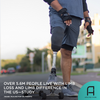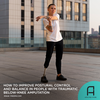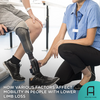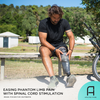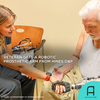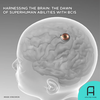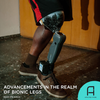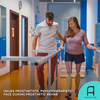Basic Driving Tips After an Amputation
If you're a new amputee, you may be wondering if you can still drive post-amputation. The good news is: Yes, you can. People with any level of lower- or upper-limb amputation can go back to doing the things they enjoyed pre-amputation, including running and cycling, albeit modified.

Reminders before driving
Depending on the condition of your residual limb and prosthesis, you may need to modify your car's setup, as well as consider driving an automatic transmission for safe and comfortable driving. If you own a vehicle that has a manual transmission, driving with a prosthesis is still possible. However, before you start re-learning how to drive, we highly recommend consulting your prosthetist, primary care doctor, and physical therapist, all of whom can determine if you are ready, as well as direct you in finding the appropriate equipment. They are also the best sources of advice on which car modifications are best for your situation.
As for the legalities, you will need to update your information and report your amputee life to your state's driving license office. They will tell you what the next steps are to continue to drive legally. Often, this step requires retaking your license exam and placing an additional endorsement on your license.
Driving with an upper-limb amputation
Above- or Below-Elbow Amputation – Single Arm
You may add a steering knob for better one-hand control. Depending on which arm has experienced an amputation, you may also need to modify your dashboard controls for easy access to the headlights, turn signals, and wipers.
Bilateral Upper Limb Amputation - Full or Partial
A foot steering system may be the best system for you. It allows you to control steering, as well as activate the dashboard functions using just one foot.
Partial Hand Amputation
The extent of your injury will determine how to modify your car best. You may be able to control the vehicle as you normally would or with minor modifications using your residual limb or prosthesis. However, if your grip is compromised, or you find steering the wheel and using the dashboard difficult, consult your healthcare team to find out which modifications suit you.
Driving with a lower-limb amputation
Bilateral Lower Limb Amputation – Full or Partial
Driving your car using special hand controls is best for your situation. There are also different setups and models available. Often, this setup requires a lever for your left arm to control braking and accelerating, as well as a steering knob for one-hand steering.
Above- or Below-Knee Amputation – Right Leg
You can have your car specially modified and have the accelerator pedal put on the left side of the brake. Another option is to use special hand controls as recommended above for those with bilateral lower-limb amputations.
Above- or Below-Knee Amputation – Left Leg
In this case, you can still drive a standard automatic car using your right leg.
Just like other modified activities, learning to drive again as an amputee takes time and patience. Be patient with yourself, and you will soon regain your independence on the road.
How do you drive your car? What modifications did you implement? Please share your experiences with the rest of the community in the comments section below.




























